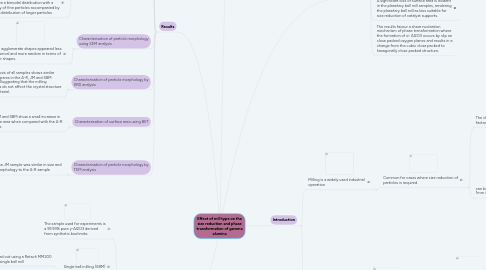
1. Materials and methods
1.1. The sample used for experiments is a 99.99% pure γ-Al2O3 derived from synthetic boehmite.
1.2. Single ball milling (SBM)
1.2.1. Was carried out using a Retsch MM200 vibratory single ball mill
1.2.1.1. For durations of up to 1200 min at a milling frequency of 30 Hz.
1.2.1.1.1. Size reduction is mainly by impact in the SBM although shear and attrition is also present during milling.
1.3. Jet milling (JM)
1.3.1. Was carried out using a Hosokawa Alpine 50AS spiral jet mill
1.3.1.1. The stress mode that effects size reduction in the air jet mill is mainly impact, by way of particle–particle and particle–wall collisions.
1.3.1.1.1. The collision energy is created by the high speed flow of compressed air
1.4. Planetary ball milling (PBM)
1.4.1. Was carried out using a Fritsch Pulverisette 7 planetary ball mill
1.4.1.1. The planetary ball mill is a high energy mill, where shearing and compression are more prevalent than high velocity collisions.
1.5. Characterisation is carried out on the as-received (A-R) γ-Al2O3 sample and after milling on the
1.5.1. SBM, PBM and JM samples using laser diffraction
1.5.1.1. Laser diffraction, has been carried out for particle size analysis, using water as carrier medium.
1.5.2. SEM
1.5.2.1. Average particle sizes were calculated from the derived size distributions of a minimum of 500 particles.
1.5.3. BET
1.5.3.1. Analyse any changes in specific surface area in the different mills.
1.5.4. TEM
1.5.4.1. To characterise the crystallite morphology of γ-Al2O3 samples.
2. Results
2.1. Particle size analysis using laser diffraction
2.1.1. Was a significant size reduction between the as-received (A-R) samples and the sample after 20 passes
2.2. γ-Al2O3 particles before and after dry milling in the SBM
2.2.1. Show particle size reduction with increased milling time
2.3. γ-Al2O3 particles before and after dry milling in the PBM
2.3.1. The results show an initial significant decrease in particle size between the A-R sample and the sample after 10 min of milling
2.4. Comparison of dry milling using different mills
2.4.1. Show that the greatest size reduction of particles was achieved with the JM, albeit this gave a bimodal distribution with a majority of fine particles accompanied by smaller distribution of larger particles
2.5. Characterisation of particle morphology using SEM analysis
2.5.1. The agglomerate shapes appeared less spherical and more random in terms of their shapes.
2.5.1.1. The agglomerate surfaces also appeared rougher
2.6. Characterisation of particle morphology by XRD analysis
2.6.1. XRD analysis of all samples shows similar diffractograms in the A-R, JM and SBM samples. Suggesting that the milling processes do not affect the crystal structure of the material.
2.6.1.1. Dry planetary ball milling results in a change in the crystal structure of the material and induces a phase transformation from the γ- to the α-alumina phase correlating with the reduction in the surface area observed
2.7. Characterisation of surface area using BET
2.7.1. the JM and SBM show a small increase in surface area when compared with the A-R sample.
2.7.1.1. There is a significant decrease in specific surface area for the PBM sample
2.7.1.1.1. The reduction in surface area in the PBM reflects a change in the structure of the sample during milling
2.8. Characterisation of particle morphology by TEM analysis
2.8.1. The JM sample was similar in size and morphology to the A-R sample
2.8.1.1. The primary crystals in the SBM samples appear slightly larger than those in the A-R and JM samples, providing evidence for coarsening of γ-Al2O3 particles with milling.
2.8.1.1.1. The PBM samples, which from XRD had transformed to α-Al2O3, showed more octahedral-shaped crystallites
3. Introduction
3.1. Milling is a widely used industrial operation
3.1.1. Common for cases where size reduction of particles is required
3.1.1.1. The choice of mill is based on a variety of factors
3.1.1.1.1. Properties of the material to be milled
3.1.1.1.2. Failure mode
3.1.1.1.3. the required product particle size
3.1.1.2. can be used to achieve particles less than 1mm in diameter
3.1.1.2.1. Ball mills
3.1.1.2.2. Vibratory mills
3.1.1.2.3. Rod mills
3.1.1.2.4. Jet mills
3.2. Gamma alumina
3.2.1. Is a versatile material used in many applications
3.2.1.1. Due to its favourable properties which include a high surface area and porous morphology for good dispersion of metal catalysts as well as thermal and chemical stability for use in different catalytic reactions
3.2.1.1.1. However, in order for the γ-Al2O3 to be fit for use as a catalyst support, it has to be reduced in size by milling.
3.2.2. Is derived from the dehydration of Boehmite(γ-AlOOH) as one of the transition aluminas
4. Discussion of particle size and particle morphology results
4.1. The results suggest that a different mechanism to that of dehydration occurs during milling. It is observed that size reduction by impact in the SBM and JM does not initiate phase change. However, the effect of shearing that is present in the PBM may be the main initiator of phase change by a shear-induced nucleation approach
4.2. It can therefore be suggested that the mode of mechanical energy supplied; impact, shear, attrition, as well as the amount of localised energy successfully transferred from the mill to the powder during milling determines whether mechanochemistry will occur.
5. Conclusions
5.1. Jet milling is a more suitable size reduction method for dry milling of γ-Al2O3 powders
5.1.1. As it effectively reduces size with minimal effect on the morphology of the material.

